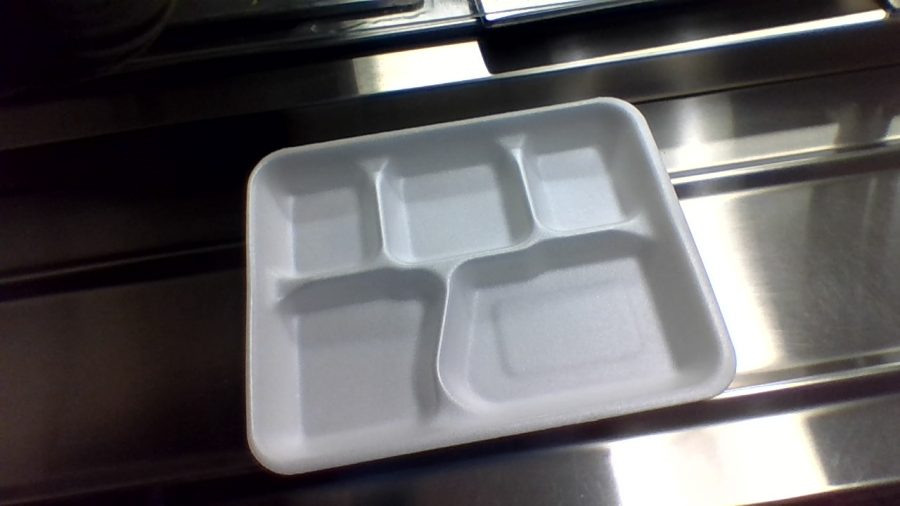West Middle School should stop using styrofoam lunch trays!
November 18, 2019
Styrofoam is one of the most harmful substances to us on our planet. Unfortunately, approximately 200 styrofoam plates are used at West Middle School each day!
Styrofoam is made of styrene, a chemical with ties to cancer, and puffed plastic. The chemicals can enter your body when you touch it. When they evaporate, we breathe it in and it is harmful to our lungs. It can also damage the earth’s ozone layer, which protects us from the sun’s UV rays. If you have warm food or liquids in styrofoam containers, the chemicals can migrate into them. When styrofoam ends up in a landfill, it takes hundreds of years to break down. Its chemicals remain in the soil for years (https://www.baltimoresun.com and https://greendiningalliance.org).
The pros of styrofoam plates are that they are very cheap, at only 3.5 cents per tray. They can be easily disposed of, and are very light. The cons of styrofoam are they do not biodegrade, they are not able to be recycled, and are harmful to ourselves and the environment.
Bio-degradable plates are a good alternative to styrofoam. they can break down into the earth in a short period of time. They become part of the soil and do not harm the environment. Bio-degradable plates don’t need to be washed and can be disposed of easily. There is one problem: Bio-degradable plates are more expensive. On one website, they are nine cents per plate (https://www.webstaurantstore.com).
Why do we have styrofoam at West? We interviewed Ms. Becky the lunch many said that West uses approximately 200 styrofoam plates a day. We use them because “nobody wants to stay and wash dishes. The styrofoam plates are more economical” She stated that bio-degradable plates would “have to be cost-effective” if the school district is going to use them.
There are many different options to styrofoam trays, but they all have negatives with their positives. One solution is to get washable plates to be reused, this would solve the problem of styrofoam but create another. It would take a lot of work to wash all the dishes, but even if we got dishwashers we would use way too much water, which would be expensive and waste our water supply. Another solution is biodegradable plates, These would be perfect, but they are much more expensive, they cost 5.5 cents more. This doesn’t seem like much of a difference, but it adds up. For example, 500 plates of styrofoam cost $17.50, and 500 biodegradable plates cost $45.
Some cities and states are taking responsibility for their planet and have banned styrofoam. Seattle, San Francisco, Portland, and Washington D.C. all have banned it. In some schools in New York, there are “Trayless Tuesdays.” This has reduced the amount of styrofoam used at that school by about 20%.
It is estimated there are 270 metric tons of plastic marine pollution, which includes styrofoam. If we get rid of styrofoam at our school, it will a small step for making the world a better place.
Works Cited
how_long_does_it_take_garbage_to_decompose.pdf
Polystyrene Fact Sheet: 8 reasons to ban Styrofoam | Green Dining Alliance
FAQs – Getting Styrofoam Out of Schools – Cafeteria Culture
Maryland is poised to become the first state to ban foam food packaging
www.baltimoresun.com
www.greendiningalliance.org










Olga • Feb 14, 2020 at 12:49 pm
I think the biodegradable plates are a good idea
maddi • Feb 4, 2020 at 9:55 am
I hate styrofoam
Joseph Tulchinsky • Jan 10, 2020 at 12:54 pm
Why are they using dangourus plates. that has to break some health codes.
Joe Dadda • Dec 16, 2019 at 2:22 pm
tbh lets just eat the trays because they be vibin
plague bearer • Dec 13, 2019 at 1:11 pm
I think we should get the reusable plates don’t be cheap
Really? • Dec 13, 2019 at 1:04 pm
Biodegradable plates = good health
Someone • Dec 13, 2019 at 12:56 pm
We should get biodegradable plates so we can help the environment and it will be more healthy for us.
billy bob • Dec 13, 2019 at 12:51 pm
we still pay more for lunch than the bio degradible plates so come on west!!!
kid • Dec 13, 2019 at 12:50 pm
I think that breaks a couple safty rules.
kid • Dec 13, 2019 at 12:49 pm
why are they using styrofoam trays if they leed to cancer?
A Nonny Mouse • Dec 5, 2019 at 12:43 pm
Anyone who disagrees with this article probably doesn’t care about the environment. It was that grouchy attitude that turned lake Erie green.
Allie W • Dec 4, 2019 at 12:51 pm
I believe we need biodegradable plates for students to stay healthy and clean!
that guy typed this on • Nov 26, 2019 at 12:57 pm
why dont we ship the trays off to space?!
Doge4Life • Nov 26, 2019 at 12:44 pm
This is a concern, but when you think about it, if we switched to bio-degradable plates, the school would not be as well maintained as it is right now.
jozef nikollbibaj • Nov 26, 2019 at 12:41 pm
Just get the biodegradable plates I looked up how much it cost for 200 of them and it cost 18 dollars don’t be cheap west.
JAKE LUDWIg • Nov 25, 2019 at 12:47 pm
I think the food should be better before they worry about the plates
Aiden M. • Nov 22, 2019 at 12:52 pm
Why are you complaining? what will you use instead of styrofoam plates? if we do that the lunch ladies will have to wash the dishes every day or maybe an hour! we’re a school we learn and I quite frankly care more about the food I’m being served.
A concerned citizen • Apr 29, 2022 at 12:49 pm
Did you even read the article? The article said there would be biodegradable plates, not dishes. There is no washing required.
Name (required) • Nov 20, 2019 at 12:47 pm
I think the styrofoam trays are fine for now and we don’t need regular plates.!
Aaron salamay • Nov 19, 2019 at 2:53 pm
I think that the students colud sign up to help with the dishes after lunch
A Nonny Mouse • Nov 19, 2019 at 8:55 am
I believe that spending a little more money on trays is better than risking the OZONE LAYER and the Health of children.